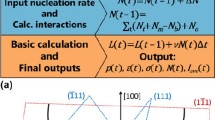Abstract
For the first time, an equation is derived that relates the misfit parameter f, the number of misfit dislocation (MD) families, and the distances between MDs of the same family, and the projection value of edge Burger’s vector component on the interface. The equation is valid for various interface boundaries (hkl). To derive this equation, the long-range normal and shear stresses associated with MD distribution are considered. The optimum and nonoptimum stress releasing processes are discussed. The problem of threading dislocation density diminution with generation of the intersecting MDs having the same Burger’s vector (L-shaped MDs) is considered for (001) and (111) interfaces. It is shown that such MDs can be effectively generated only at the initial stage of the releasing process, since generating is accompanied by the increase in the level of long-range shear stresses.
Similar content being viewed by others
References
Matthews, J.W., Fracture and the formation of misfit dislocations between PbS and PbSe, Philos. Mag., 1971, vol. 23, no. 186, pp. 1405–1416.
Matthews, J.W., Defects associated with the accommodation of misfit between crystals, J. Vac. Sci. Technol., 1975, vol. 12, pp. 126–133.
LeGous, F.K., Horn von Hoegen, M., Copel, M., and Tromp, R.M., Strain-relief mechanism in surfactantgrown epitaxial germanium films on Si(111), Phys. Rev. B, 1991, vol. 44, pp. 12894–12902.
Volyntsev, A.B., Nasledstvennaya mekhanika dislokatsionnykh ansamblei. Komp’yuternoe modelirovanie i eksperiment (Hereditary Mechanics of Dislocation Ensembles. Computer Modeling and Experiment), Irkutsk: Irkursk. Gos. Univ., 1990.
Pintus, S.M., Latyshev, A.V., Aseev, A.L., and Karasev, V.Yu., Dislocation structure of limit of the section Ge–Si(111), Poverkhnost’, 1984, no. 8, pp. 60–65.
Truhanov, E.M., Loshkarev, I.D., Romanyuk, K.N., Il’in, A.S., Gutakovskii, A.K., Kolesnikov, A.V., and Kachanova, M.M., Tension and dislocation structure of heterosystems Ge/Si with interfaces (001), (111) and (7710), Fazov. Perekh., Uporyadoch. Sostoyan. Nov. Mater., El. Zh., 2011, July 5. http://ptosnm.ru/
Trukhanov, E.M., Loshkarev, I.D., Romanyuk, K.N., Gutakovskii, A.K., Ilin, A.S., and Kolesnikov, A.V., Structural state of Ge/Si heterosystems with (001), (111), and (7710) interfaces, Bull. Russ. Acad. Sci.: Phys., 2012, vol. 76, no. 3, pp. 325–327.
Trukhanov, E.M., Kolesnikov, A.V., and Loshkarev, I.D., Emergence of long-range fields of normal and shift tension during discrepancy dislocations introduction, in Tezisy. dokl. mezhdunarodnoi konf. Kremnii-2012 (Proceedings of the International Conference Silicon 2012), St.-Petersburg, 2012, p. 84.
Trukhanov, E.M., Gorokhov, E.B., and Stenin, S.I., Specific features of the dislocation structure of germanium in the system Ge–SiO2, Phys. Status Solidi, 1976, vol. 33, pp. 435–442.
Dimitrienko, Yu.I., Tenzornoe ischislenie (Tensor Calculation), Moscow: Vysshaya Shkola, 2001.
Trukhanov, E.M., Influence of discrepancy dislocation type on energy and structure of epitaxial films, Poverhnost’, 1995, no. 2, pp. 13–21.
Hirth, J. and Lotte, J., Theory of Dislocations, New York: McGraw-Hill, 1967.
Fridel, J., Dislocations, Oxford: Pergamon, 1964.
Trukhanov, E.M., Kolesnikov, A.V., Vasilenko, A.P., and Gutakovski, A.K., Influence of misfit dislocation screw component on the formation of threading dislocations in semiconductor heterostructures, Semiconductors, 2002, vol. 36, no. 3, pp. 290–297.
Timoshenko, S.P. and Goodier, J., Theory of Elasticity, New York: McGraw-Hill, 1951.
Trukhanov, E.M., Ilin, A.S., Krasotin, A.Yu., Vasilenko, A.P., Deryabin, A.S., Kachanova, M.M., and Gutakovsky, A.K., Kolesnikov, A.V., Role of the dislocation screw component in the formation of the dislocation structure in Geand Si-based semiconductor heterosystems, J. Surf. Invest.: X-ray, Synchrotron Neutron Tech., 2007, vol. 1, no. 5, pp. 247–254.
Thorik, Yu.A. and Hazan, L.S., Plasticheskaya deformatsiya i dislokatsiya nesootvetstviya v geteroepitaksial’nykh sistemakh (Plastic Deformation and Discrepancy Dislocations in Heteroepitaxial Systems), Kiev: Naukova Dumka, 1983.
Mil’vidskii, M.G. and Osvenskii, B.V., Strukturnye defekty v epitaksial’nykh sloyakh poluprovodnikov (Structural Defects in Epitaxial Layers of Semiconductors), Moscow: Metallurgiya, 1985, p. 51.
LeGoues, F.K., Self-aligned sources for dislocation nucleation: the key to low threading dislocation densities in compositionally graded thin films grown at low temperature, Phys. Rev. Lett., 1994, vol. 72, no. 6, pp. 876–879.
Strunk, H., Hagen, W., and Bauser, E., Low-density dislocation arrays at heteroepitaxial Ge/GaAs-interfaces investigated by high voltage electron microscopy, J. Appl. Phys., 1979, vol. 18, pp. 67–75.
LeGoues, F.K., Meyerson, B.S., Morar, J.F., and Kirchner, P.S., Mechanism and conditions for anomalous strain relaxation in graded thin-films and superlattices, J. Appl. Phys., 1992, vol. 71, no. 9, pp. 4230–4243.
Vdovin, V.I., Misfit dislocations in epitaxial heterostructures: mechanisms of generation and multiplication, Phys. Status Solidi A, 1998, vol. 171, pp. 239–250.
Beanland, R., Dislocation multiplication mechanisms in low-misfit strained epitaxial layers, J. Appl. Phys., 1995, vol. 77, no. 12, pp. 6217–6222.
Jasinski, J., Lilientalweber, Z., Washburn, J., Tan, H.H., Jagadish, C., Krotkus, A., Marcinkevicius, S., and Kaminska, M., Structural, electrical, and optical studies of GaAs implanted with MeV As or Ga ions, J. Electron. Mater., 1997, vol. 26, no. 5, pp. 449–458.
LeGoues, F.K., Powell, A., and Iyer, S.S., Relaxation of sige thin-films grown on Si/SiO2 substrates, J. Appl. Phys., 1994, vol. 75, no. 11, pp. 7240–7246.
Read, W.T., Dislocations in Crystals, New York: McGraw-Hill, 2010.
Loshkarev, I.D., Trukhanov, E.M., Romanyuk, K.N., and Kachanova, M.M., Theoretical and experimental determination of the initial stage of plastic relaxation of misfit stresses in a (111) substrate-film islands heterosystem, Bull. Russ. Acad. Sci.: Phys., 2012, vol. 76, no. 3, pp. 374–377.
Author information
Authors and Affiliations
Corresponding author
Additional information
Original Russian Text © E.M. Trukhanov, A.V. Kolesnikov, I.D. Loshkarev, 2014, published in Izvestiya Vysshikh Uchebnykh Zavedenii. Materialy Elektronnoi Tekhniki, 2014, No. 1, pp. 24–31.
Rights and permissions
About this article
Cite this article
Trukhanov, E.M., Kolesnikov, A.V. & Loshkarev, I.D. Long-range stresses generated by misfit dislocations in epitaxial films. Russ Microelectron 44, 552–558 (2015). https://doi.org/10.1134/S1063739715080119
Received:
Published:
Issue Date:
DOI: https://doi.org/10.1134/S1063739715080119




